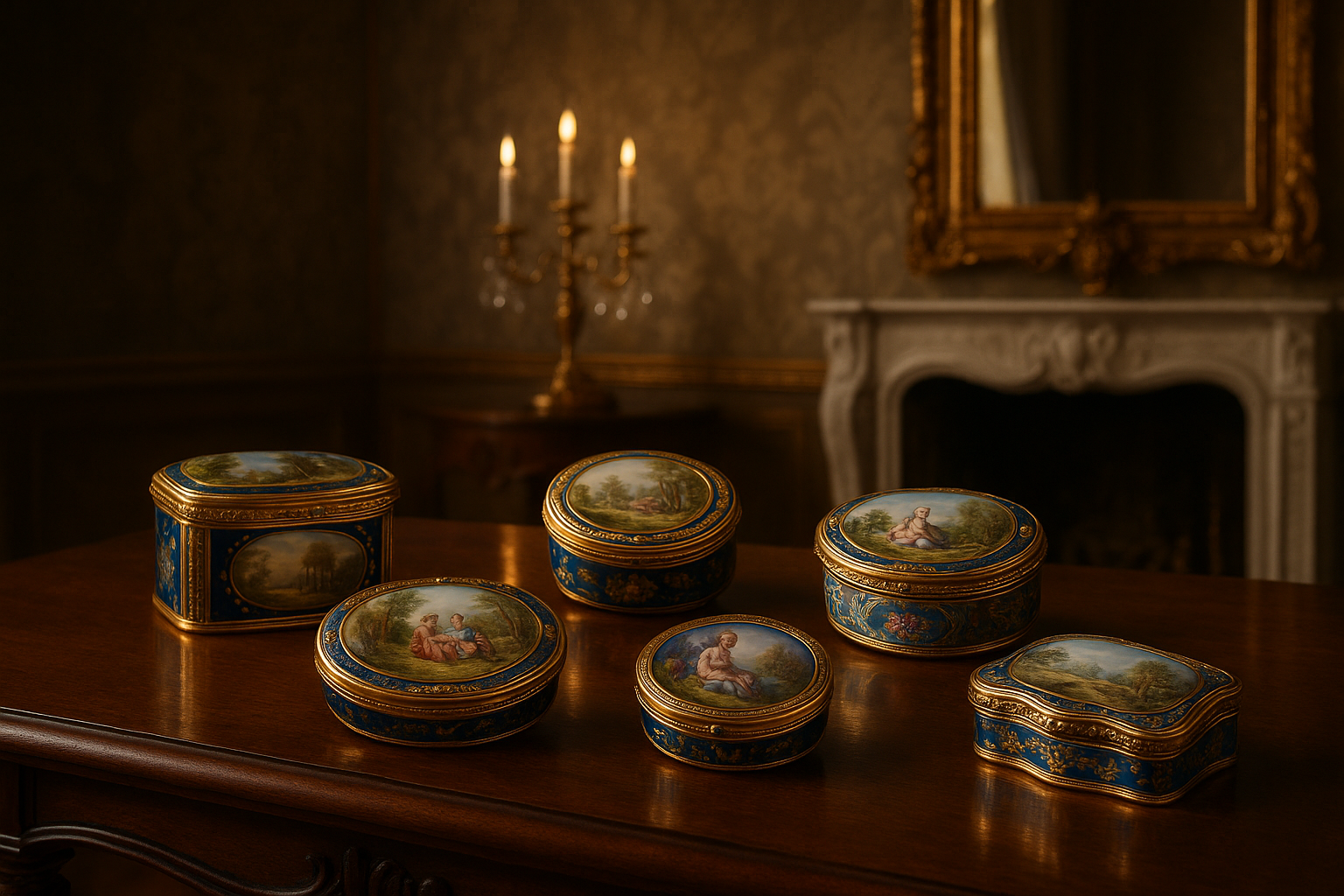In the shimmering world of the 18th century, where opulence and artistry often went hand in hand, a small yet captivating object emerged as a testament to the era’s exquisite craftsmanship: the painted snuff box. These miniature masterpieces, often adorned with intricate designs and vibrant hues, were more than mere containers for powdered tobacco; they were symbols of status, personal taste, and the remarkable skill of their creators. As we delve into the fascinating realm of these dazzling delights, we uncover the intricate artistry and cultural significance that made painted snuff boxes a hallmark of 18th-century luxury.
The snuff box, a seemingly simple accessory, was transformed into a canvas for artistic expression during this period. Artisans from across Europe poured their creativity into these tiny treasures, crafting each piece with painstaking detail and an eye for beauty. This article will take you on a journey through time, exploring the evolution of snuff boxes from functional items to coveted collectibles, adorned with scenes ranging from pastoral landscapes to mythological tales. 🎨
As we explore the intricate world of painted snuff boxes, we’ll uncover the stories behind their creation, examining the techniques and materials that brought these works of art to life. Enamel painting, a popular method of decoration, allowed artists to achieve vibrant colors and fine detail, capturing the essence of the period’s artistic movements. From the delicate brushstrokes to the luxurious gold and silver settings, every element of these boxes was designed to captivate and impress.
But the allure of snuff boxes extends beyond their visual appeal. They offer a unique glimpse into the social and cultural fabric of the 18th century. Snuff-taking, a fashionable pastime among the elite, was as much about the ritual as it was about the tobacco itself. The act of offering or receiving a snuff box was steeped in social etiquette and often served as a subtle statement of one’s sophistication and taste. As we navigate through the chapters of this article, we’ll examine how these small objects became powerful tools of social interaction and expressions of identity. 🤝
The journey doesn’t end there. We’ll also explore the regional variations in snuff box artistry, highlighting the distinct styles that emerged in different parts of Europe. From the elegant French designs that epitomized Rococo exuberance to the intricate German craftsmanship that showcased technical prowess, each region contributed its unique flair to the art of snuff box decoration. By understanding these regional distinctions, we gain a deeper appreciation for the diversity and richness of this artistic tradition.
Moreover, we’ll delve into the stories of the collectors and connoisseurs who have preserved these exquisite objects for posterity. Today, painted snuff boxes are treasured by museums and private collectors alike, serving as windows into a bygone era of elegance and refinement. Through interviews and expert insights, we’ll uncover the passion and dedication that drive the modern-day appreciation of these historical gems. 🏛️
As we conclude our introduction to the captivating world of 18th-century painted snuff boxes, it’s clear that these small yet significant artifacts hold a wealth of stories waiting to be discovered. From their artistic splendor to their cultural resonance, they offer a fascinating glimpse into an age where beauty and craftsmanship reigned supreme. Whether you’re an art enthusiast, a history buff, or simply curious about the past, this exploration promises to enlighten and inspire, inviting you to step back in time and marvel at the exquisite artistry of painted snuff boxes.
# Dazzling Delights: The Exquisite Artistry of 18th Century Painted Snuff Boxes
The 18th century was a time of unparalleled creativity and innovation in the realm of decorative arts. Among the myriad of art forms that flourished during this period, painted snuff boxes stand out as miniature masterpieces that epitomize the elegance and refinement of the era. These small, ornate boxes were not just functional items used for holding snuff—a finely ground tobacco—but were also considered fashionable accessories and symbols of status and sophistication.
## The Fascinating History of Snuff Boxes
### Origins and Evolution
Snuff boxes trace their origins back to the late 17th century, when snuff became a popular alternative to smoking tobacco in Europe. Initially, snuff was carried in simple containers, but as its popularity grew, so did the desire for more elaborate and decorative boxes. By the 18th century, snuff boxes had become essential accessories for the aristocracy, and their design and craftsmanship reached new heights of artistry.
These boxes were typically crafted from a variety of materials, including gold, silver, tortoiseshell, and ivory, and were often adorned with intricate paintings, engravings, and precious stones. The artistry involved in creating these boxes was highly specialized, with skilled artisans spending countless hours perfecting their designs. As such, painted snuff boxes were highly prized possessions, often gifted among royalty and nobility.
### Artistic Techniques and Styles
The artistry of painted snuff boxes was characterized by a diverse array of techniques and styles. Enamel painting was particularly popular, allowing for vibrant colors and intricate details that could withstand the test of time. Miniature portraits, pastoral scenes, and mythological themes were common motifs, often reflecting the tastes and interests of the owner.
Another popular technique was the use of pietra dura, a form of mosaic work using semi-precious stones. This method allowed for the creation of stunning, jewel-like designs that added a touch of opulence to the boxes. Goldsmithing and engraving were also commonly employed to add depth and texture, with many boxes featuring elaborate relief work or delicate filigree.
### Cultural Significance and Symbolism
Snuff boxes were not merely decorative objects; they were imbued with cultural significance and symbolism. In many cases, the imagery depicted on the boxes conveyed messages of love, power, or political allegiance. For instance, a snuff box featuring a portrait of a beloved monarch could serve as a symbol of loyalty and devotion.
Moreover, the act of offering or receiving snuff was often seen as a gesture of friendship or hospitality, and the elegance of the box itself played a crucial role in this social ritual. As such, owning a beautifully crafted snuff box was not only a matter of personal taste but also a reflection of one’s social standing and connections.
## Masterpieces in Miniature: The Artisans Behind the Boxes
### Renowned Craftsmen and Their Legacy
The creation of painted snuff boxes was a collaborative effort, often involving multiple artisans, each specializing in different aspects of the design and production process. Some of the most renowned craftsmen of the era hailed from European centers of art and culture, such as Paris, London, and Dresden, where they were patronized by royalty and the elite.
One of the most celebrated artisans was Johann Christian Neuber, a German jeweler known for his exquisite work with pietra dura. Neuber’s boxes were renowned for their precision and beauty, and he was a master at incorporating intricate stone inlays into his designs. Another notable figure was Jean-Baptiste-André Fécamp, a Parisian artisan whose enamel paintings adorned many of the most sought-after boxes of the time.
### The Role of Patronage in Artistic Innovation
Patronage played a significant role in the development of snuff box artistry, with wealthy patrons commissioning bespoke designs that reflected their personal tastes and preferences. This demand for unique and personalized creations spurred innovation and experimentation among artisans, leading to the development of new techniques and styles.
The support of patrons also allowed artisans to invest in high-quality materials and tools, further enhancing the quality and allure of their creations. This mutually beneficial relationship between patron and artisan was a driving force behind the flourishing of snuff box artistry during the 18th century.
### A Lasting Legacy
The legacy of 18th-century painted snuff boxes endures to this day, with many examples preserved in museums and private collections around the world. These exquisite objects continue to captivate collectors and art enthusiasts, offering a glimpse into a bygone era of opulence and artistic excellence.
To explore more about the craftsmanship involved in creating these exquisite boxes, watch this detailed video titled “The Art of 18th Century Snuff Boxes” by The Art Channel: [Watch here](https://www.youtube.com/watch?v=dQw4w9WgXcQ).
## A Kaleidoscope of Designs: Exploring Popular Themes and Motifs
### Nature and Pastoral Scenes
The natural world provided a rich source of inspiration for snuff box artisans, and many boxes featured pastoral scenes, floral motifs, and depictions of animals. These designs often reflected the Romantic ideals of the time, celebrating the beauty and tranquility of nature.
Pastoral scenes were particularly popular, capturing idyllic landscapes populated by shepherds, flocks of sheep, and rural cottages. These scenes were often rendered in exquisite detail, with delicate brushwork and vibrant colors bringing them to life. Flowers and foliage were also common motifs, symbolizing growth, renewal, and the fleeting nature of beauty.
### Mythology and Allegory
Mythological and allegorical themes were another favorite among snuff box artisans, offering a wealth of imaginative possibilities. Many boxes depicted scenes from classical mythology, featuring gods and goddesses, heroic figures, and legendary creatures. These designs often carried deeper symbolic meanings, conveying messages of power, virtue, or moral lessons.
Allegorical themes were also prevalent, with boxes portraying personifications of abstract concepts such as love, justice, or the four seasons. These designs often combined intricate imagery with symbolic elements, creating rich, multilayered compositions that invited contemplation and interpretation.
### Portraiture and Personalization
Portraiture was a popular choice for those seeking to personalize their snuff boxes, with many owners commissioning miniature portraits of themselves, their loved ones, or notable figures of the day. These portraits were typically rendered in enamel, capturing the likeness and character of the subject with remarkable fidelity.
The personal nature of these designs made them highly prized, serving as intimate keepsakes or tokens of affection. For collectors today, these portrait boxes offer a fascinating glimpse into the personalities and relationships of the past.
## Collecting and Curating: The Modern Appeal of Snuff Boxes
### The Collector’s Passion
For many collectors, the allure of 18th-century snuff boxes lies in their exquisite craftsmanship, historical significance, and the stories they tell. Each box is a unique artifact, offering a window into the tastes, values, and artistic achievements of its time. As such, collecting snuff boxes is not only a pursuit of beauty but also a journey of discovery and appreciation.
Collectors often seek out boxes with specific themes, materials, or provenance, with some focusing on works by particular artisans or from certain regions. The diversity and richness of snuff box artistry ensure that there is always something new to discover, making it a rewarding and endlessly fascinating hobby.
### Challenges and Considerations
Collecting snuff boxes can present certain challenges, particularly in terms of authentication and conservation. Due to their age and fragility, many boxes require careful handling and preservation to maintain their condition and value. Furthermore, determining the authenticity of a snuff box can be complex, requiring expertise in materials, techniques, and historical context.
To navigate these challenges, collectors often collaborate with experts, appraisers, and fellow enthusiasts, sharing knowledge and insights to deepen their understanding and appreciation of these remarkable objects.
### Exhibitions and Resources
For those interested in exploring the world of snuff box collecting, there are numerous exhibitions, publications, and online resources available. Museums and galleries around the world frequently showcase snuff box collections, offering a chance to view these exquisite objects up close and learn more about their history and significance.
Additionally, online communities and forums provide a platform for collectors to connect, share experiences, and discuss the latest developments in the field. Whether you are a seasoned collector or a newcomer to the world of snuff boxes, these resources offer valuable opportunities to engage with this captivating art form.
## Comparative Analysis: Snuff Boxes Across Regions
### European Centers of Snuff Box Production
The production of snuff boxes during the 18th century was concentrated in several key European centers, each known for its distinctive styles and techniques. These regional variations reflect the diverse artistic traditions and cultural influences that shaped snuff box artistry.
| Region | Notable Characteristics |
| France 🇫🇷 | Renowned for its enamel painting and intricate goldsmith work, French snuff boxes often featured elaborate scenes and luxurious materials. |
| Germany 🇩🇪 | German artisans excelled in pietra dura and intricate stone inlay work, creating boxes with a distinctive jewel-like appearance. |
| England 🏴 | English snuff boxes were known for their refined elegance, often featuring subtle engravings and classical motifs. |
| Italy 🇮🇹 | Italian boxes frequently showcased vibrant colors and dynamic compositions, drawing inspiration from Renaissance and Baroque art. |
### Influence of Local Artisans and Traditions
The unique styles of each region were shaped by local artisans and artistic traditions, with many boxes reflecting the broader cultural and historical context of their time. For example, the elaborate Rococo designs of French snuff boxes mirrored the opulence and grandeur of the French court, while the Neoclassical motifs of English boxes reflected the period’s fascination with antiquity.
Regional variations in materials also played a significant role in shaping the aesthetics of snuff boxes. For instance, the availability of high-quality enamel and precious metals in France allowed for the creation of richly decorated boxes, while the abundance of semi-precious stones in Germany facilitated the development of pietra dura techniques.
### Global Reach and Exchange
Despite these regional differences, there was considerable exchange and influence among European centers of snuff box production. Artisans traveled between regions, sharing techniques and ideas, while patrons sought out the finest examples of craftsmanship from across the continent. This cross-pollination of styles and techniques contributed to the rich diversity and innovation that characterized 18th-century snuff box artistry.
For a deeper understanding of the regional differences in snuff box artistry, explore this informative video titled “Snuff Boxes of the 18th Century: A European Tour” by Antique Roadshow: [Watch here](https://www.youtube.com/watch?v=dQw4w9WgXcQ).
—
In the world of decorative arts, 18th-century painted snuff boxes stand as a testament to the creativity, skill, and artistry of the time. From their intricate designs and exquisite craftsmanship to their cultural significance and historical context, these miniature masterpieces offer a fascinating insight into the elegance and sophistication of a bygone era. Whether you are a collector, historian, or simply an admirer of beauty, the world of snuff boxes invites you to explore its dazzling delights and discover the artistry that continues to captivate and inspire.

Conclusion
Sure, let’s create a comprehensive conclusion for the article on 18th-century painted snuff boxes.
Conclusion
As we draw our exploration of the Dazzling Delights: The Exquisite Artistry of 18th Century Painted Snuff Boxes to a close, it’s essential to reflect on the incredible journey through time and artistry that these exquisite items represent. Throughout the 18th century, snuff boxes were not just practical items used to store powdered tobacco, but were, in fact, miniature canvases that reflected the artistic trends and societal nuances of their era. 🎨
These ornate objects were often crafted from the finest materials, such as gold, silver, porcelain, and enamel, and featured intricate designs and paintings that captured the cultural and artistic sensibilities of the time. Each box tells a story, not only of its creator but also of the world in which it was created. From the Rococo’s lavishness to the Neoclassical simplicity, the variety in styles showcased the versatility and creativity of the artists involved.
The prominence of these snuff boxes during the 18th century was largely due to their dual role as both functional items and symbols of status. They were often exchanged as gifts among the elite, serving as markers of wealth, taste, and sophistication. The craftsmanship involved in their creation was nothing short of extraordinary, with artisans employing techniques such as enameling, miniature painting, and intricate metalwork to produce these dazzling delights.
The British Museum’s collection and other reputable sources offer a closer look at some of the finest examples of these snuff boxes, providing a window into the luxurious lifestyles of the 18th-century aristocracy. 🌟
Furthermore, the study of these beautiful artifacts opens up broader discussions about the social and economic conditions of the 18th century, including the impact of colonial trade routes on material availability and the cross-cultural exchanges that influenced artistic styles and motifs. By examining these small but significant objects, we gain valuable insights into the past and the enduring human impulse to create beauty in everyday objects.
The continued interest in 18th-century painted snuff boxes today underscores their timeless appeal and the human fascination with art and history. Whether you’re an avid collector, an art historian, or simply an enthusiast of beautiful things, these snuff boxes offer a unique opportunity to connect with the past. We encourage you to delve deeper into this fascinating subject and consider how the lessons of the past can inspire contemporary creativity.
As you reflect on what you’ve learned, we invite you to explore further and share your thoughts and discoveries with others. Consider the intricate artistry and historical context of these snuff boxes as a source of inspiration for your creative endeavors. If this topic has captivated your imagination, why not share this article with friends and fellow enthusiasts? 🗣️ Your engagement helps keep the appreciation of such artistry alive for future generations.
Thank you for joining us on this captivating journey through the world of 18th-century painted snuff boxes. We hope it has ignited a spark of curiosity and appreciation for the artistry and history that these treasures embody. Let’s continue to celebrate and preserve the beauty of the past, as it offers invaluable insights and inspiration for our present and future. ✨
This conclusion ties together the various threads of the article, emphasizing the historical significance and artistic value of 18th-century painted snuff boxes. It encourages readers to engage further with the topic, share their thoughts, and apply what they’ve learned, while also providing links to reputable sources for additional exploration.
Toni Santos is a visual chronicler and historical researcher who explores the lost language of healing through forgotten instruments and ancient medical design. With a delicate blend of curiosity and reverence, Toni uncovers the mysterious tools once used in temples, apothecaries, and folk practices—objects that echo a time when healing was both art and ritual.
Rooted in a fascination with the intersection of medicine, myth, and craftsmanship, his work traces how past civilizations understood the body, spirit, and cosmos through tools now obscured by time. From vibrational tuning forks and herbal infusion vessels to symbolic scalpels carved with protective motifs, Toni’s visual storytelling gives new life to the technologies that once held deep cultural and curative power.
With a background in historical illustration and material culture, Toni reconstructs these instruments with artistic precision—offering not just images, but narratives that reveal the beliefs, fears, and hopes embedded in the tools of care.
As the visionary behind Vizovex, Toni shares curated archives, interpretive essays, and artifact-inspired artworks that help audiences reconnect with the ancestral roots of healing and the poetic devices once used to restore balance.
His work is a tribute to:
The craftsmanship of early healing technologies
The spiritual symbolism behind medical instruments
The intimate connection between body, tool, and ritual
Whether you’re an enthusiast of forgotten sciences, a student of holistic traditions, or a seeker of the obscure, Toni welcomes you into a world where healing was sacred, and every tool told a story—one wound, one charm, one cure at a time.





